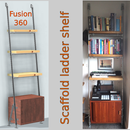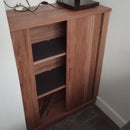Introduction: Charred Scaffold Board Table
I wanted an outdoor table in anticipation of summer and had a scaffolding board left over from making some outdoor seating.
My outdoor seating was finished by scorching the wood to create a blackened/darkened mottled effect so decided to use the same thing for this table. This is similar to Shou Sugi Ban technique which adds protection to the wood but also makes it look totally cool! To add contrast to the table top I decided to use a through mortise, so the top of the legs would be visible on the table top. These leg ends would be the only thing that wouldn't be scorched giving a light section on the darker top.
The only timber material I used was a 1800mm long 200mm x 40mm (6ft x 8in x 1 3/4in) scaffold board and a tiny bit of oak to wedge the tenons. I also used a table saw, router (in and out of table), bandsaw, clamps and chisels.
Step 1: Size and Glue Timber
Firstly I cut the scaffold board to the following sizes
3No. 750mm x 110mm (29.5" x 4.25")
4No. 450mm x 110mm (7.75" x 4.25")
2No. 240mm x 50mm (9.5" x 2")
I needed to glue the parts together so needed straight edges, so I used a planer/thicknesser (jointer/planer) so to each piece I planed two edges square and then thicknessed each part using the planed faces to make the sides parallel. One all the parts were square and parallel I glued up the table top and the two legs leaving them clamped for a few hours to dry.
Step 2: Through Mortise on the Table Top
As the glue was drying I made up a template I could use to cut the mortise. The exact dimensions weren't critical but thought having a shoulder of around 7mm would be good.
I used a router with a guide bushing to cut the mortise so made the template hole slightly bigger than the hole I needed. I ended up with a template with a hole of 250mm x 25mm (10" x 1"). The template was made of four parts, two long parts and two spacers, to create the required hole. I just used some free chipboard I got from a spare wood bin outside Ikea for this as it didn't need to be particularly robust.
I marked a centreline in the table top and the template so I could easily line up where I wanted the tenon. Using this line and the edge of the table and template i could easily make the two mortises either end of the table in exactly the right place. I fixed the template to the top with a couple of brad nails as I couldn't easily get any clamps in.
It was just a case of taking multiple passes with the router, regularly clearing the saw dust on the way. There was also a bit of chipboard under the table top so I didn't cut though my router table!
Step 3: Tenon to Top of Table Legs
Once the mortise was cut I knew the exact size I needed my tenon to be.
I used my router mounted in the table to cut the tenons. I started of with a 12.5 mm router bit but this was taking ages and wasn't giving me the finish I wanted. I then remembered i had a large diameter router bit which was large enough to cut the full height of the tenon. So I swapped to that one and made multiple passes, creeping up on the width testing the fit regularly.
I then measured the length of the mortise so I cut the ends of the tenons, on the bandsaw, to size.
As I had rounded edges on the mortise I either needed to square the mortise or round the tenon. I was most comfortable with squaring the mortise so did so using a chisel and mallet. I then test fitted the legs on to the table top which was a nice tight fit.
I then took it apart and added a chamfer to all of the edges on the router table.
Step 4: Charring the Wood
I sanded the top and legs to 120 grit as I was going to char the wood with a blow torch so it didn't need to be too smooth.
I used a weed burner I got from ebay, this one, which was really cheap and came with four gas canisters. All you need to do is burn the wood slowly until it is charred to your liking. I went for a medium char but you can go either way up until its properly burned and black. It does take a surprisingly long time to char but it's worth the effort.
Once the wood was charred I used a wire brush to get rid of the ash, this can be done quite vigorously.
Step 5: Glue Up and Finishing
I added a couple of relief holes to the tenon as I was going to use some wedges in the tenon to close the small gap up either end of the joint. I cut a 10mm hole 20mm from the end and cut out a wedge with the bandsaw.
I added glue to the tenons and shoulders of the table legs and inserted them in to the table top. I did need to persuade them in to place with a mallet as the joints were very tight with the glue but they eventually went in. I then hammered in some small part of oak I had cut to size in to the slots I had made in the tenon.
The only bit of sanding left was to hand sand the top of the legs to get a better finish.
Lastly I coated the table with UV resistant oil. I've heard that using the charring technique eliminates the need to add oil but any extra protection can't harm.
All in all I quite like this bit of outdoor furniture and looking forward to some nice weather to use it.
If you liked this Instructable please vote for it in the woodwork contest. Thanks

Participated in the
Woodworking Contest











